|

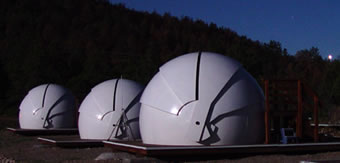
New Mexico Skies currently has six separate permanent observatories, as pictured at the
top of the page, plus an assortment of telescopes along with many accessories such as CCD
cameras and various guiders.
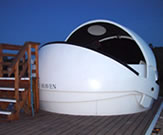  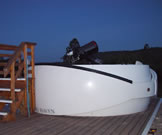
The first three of our observatories are housed in individual 12' clamshell domes by Astro
Haven. These Astro Haven domes have two major advantages over other types of observatory
domes:
(1) They are roomy and comfortable for 3-4 people. They can be partially opened to provide
wind shielding, but even fully opened, the 4' high walls provide wind insulation.
(2) Thermal equilibrium is reached rapidly with a fully open dome. The "open to the full
sky" concept the clamshell shares with a roll-off roof eliminates the seeing-destroying
thermal currents often associated with slotted/rotating domes. And, unlike a roll-off, the
sky is not obscured by the parked roof.
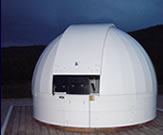  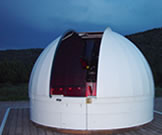
The Dome 4 observatory is housed in a 10' rotating Pro-Dome by Technical Innovations, which
is very effective in its own right. For observing in high winds, the slotted Pro-Dome is
certainly the best choice.
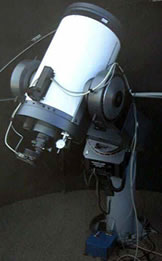 All of the observatories at New Mexico Skies have permanent telescopes mounted on concrete/steel
piers that are solidly attached to bedrock and isolated from the observatory floor. The
concrete/steel pier assemblies are truly massive, weighing in at 2-3 tons, and are pinned
and bonded directly to bedrock. The steel piers are tuned with sand to be non-resonant.
120-volt ground fault protected power outlets are provided at every pier.
All of the observatories at New Mexico Skies have permanent telescopes mounted on concrete/steel
piers that are solidly attached to bedrock and isolated from the observatory floor. The
concrete/steel pier assemblies are truly massive, weighing in at 2-3 tons, and are pinned
and bonded directly to bedrock. The steel piers are tuned with sand to be non-resonant.
120-volt ground fault protected power outlets are provided at every pier.
|
 |
 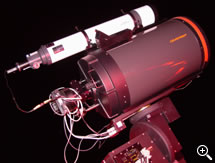 Dome 1 houses a 14" Celestron SCT on a Bisque Paramount GT-1100ME. This telescope is used
exclusively for CCD imaging with an Apogee AP6E camera equipped with a color filter wheel.
The Apogee camera features 24 micron pixels in a 1024 x 1024 array and provides a field
of view of 21 x 21 arc minutes. The telescope can be controlled from the dome or from the
remote imaging center in the library. Dome 1 includes a guidescope and an SBIG STV auto
guider. Dome 1 includes a 3 nm Hydrogen Alpha filter as well.
Dome 1 houses a 14" Celestron SCT on a Bisque Paramount GT-1100ME. This telescope is used
exclusively for CCD imaging with an Apogee AP6E camera equipped with a color filter wheel.
The Apogee camera features 24 micron pixels in a 1024 x 1024 array and provides a field
of view of 21 x 21 arc minutes. The telescope can be controlled from the dome or from the
remote imaging center in the library. Dome 1 includes a guidescope and an SBIG STV auto
guider. Dome 1 includes a 3 nm Hydrogen Alpha filter as well.
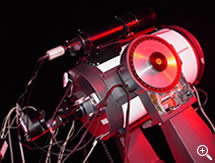 Dome 2 contains a Meade 16" LX200 computer-controlled telescope, custom modified with a
Software Bisque MKS 3000 telescope control system for superior pointing and tracking. This
telescope, like the one in Dome 1, is controlled using Software Bisque's TheSky software
and T-Point. The 16" is dedicated to CCD imaging using an Apogee AP7 camera with a
back illuminated imaging chip, 24 micron pixels and a field of view after focal reduction
of 17 x 17 arc minutes. Dome 2 is equipped with a semi-APO guidescope and an SBIG STV. Dome
2 may also be optionally controlled from the remote imaging lab.
Dome 2 contains a Meade 16" LX200 computer-controlled telescope, custom modified with a
Software Bisque MKS 3000 telescope control system for superior pointing and tracking. This
telescope, like the one in Dome 1, is controlled using Software Bisque's TheSky software
and T-Point. The 16" is dedicated to CCD imaging using an Apogee AP7 camera with a
back illuminated imaging chip, 24 micron pixels and a field of view after focal reduction
of 17 x 17 arc minutes. Dome 2 is equipped with a semi-APO guidescope and an SBIG STV. Dome
2 may also be optionally controlled from the remote imaging lab.
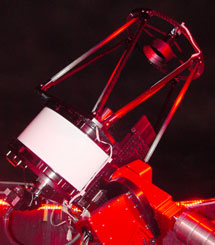 Dome 3 contains an unparalleled .51 meter (20") at f/6.0 RCOS Ritchey-Chretien truss
tube telescope mounted on a Bisque Paramount ME. The camera is an SBIG ST-10XME, 2184 x
1472 pixels, each 6.8 microns square. The telescope is equipped with a Precision Instrument
Rotator and an SBIG AO-7 Adaptive optics device. The field of view is 11 x 17 arc-minutes.
This telescope is dedicated to advanced CCD imaging and is only available to experienced
imagers.
Dome 3 contains an unparalleled .51 meter (20") at f/6.0 RCOS Ritchey-Chretien truss
tube telescope mounted on a Bisque Paramount ME. The camera is an SBIG ST-10XME, 2184 x
1472 pixels, each 6.8 microns square. The telescope is equipped with a Precision Instrument
Rotator and an SBIG AO-7 Adaptive optics device. The field of view is 11 x 17 arc-minutes.
This telescope is dedicated to advanced CCD imaging and is only available to experienced
imagers.
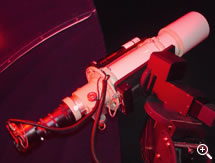 Dome 4 has a fabulous Takahashi FCT-150 triplet flourite Apochromatic
refractor (formally owned by Rob Gendler and Ron Wodaski). It is
used at f/7.0 with an SBIG ST-10XME CCD camera. Dome 4 is equipped
with a Borg ED guidescope with an SBIG STV.
Dome 4 has a fabulous Takahashi FCT-150 triplet flourite Apochromatic
refractor (formally owned by Rob Gendler and Ron Wodaski). It is
used at f/7.0 with an SBIG ST-10XME CCD camera. Dome 4 is equipped
with a Borg ED guidescope with an SBIG STV.
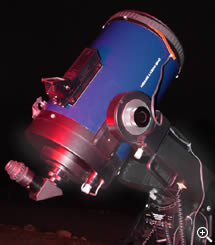 Between
Dome 4 and Pad 6 is an equatorially mounted 12" Meade SCT LX200 (a smaller version
of the 16" Meade in Dome 2). The 12" is a full-featured LX200 with 65,000 object
libary, 8 pointing speeds, and 1 arc-minute high precision pointing. The forte of this telescope
is its instant "GOTO" operation. This makes visual observing effortless and great
fun; ideal for the beginner as well as more advanced astronomers. Between
Dome 4 and Pad 6 is an equatorially mounted 12" Meade SCT LX200 (a smaller version
of the 16" Meade in Dome 2). The 12" is a full-featured LX200 with 65,000 object
libary, 8 pointing speeds, and 1 arc-minute high precision pointing. The forte of this telescope
is its instant "GOTO" operation. This makes visual observing effortless and great
fun; ideal for the beginner as well as more advanced astronomers.
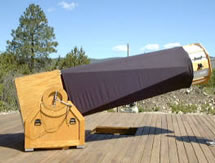 Pads 5 and 6 are the homes for our BIG Dobs: a 30" f/5.0 Tectron, a 25" f/4.0 Galaxy
Mirror/ AstroSystems Telekit and a 15" f/4.0 AstroSystems Telekit. Each of our big Dobsonians
is equipped with a Telrad and Sky Commander digital setting circles. The Sky Commanders
make finding faint fuzzies extremely easy, and we'll teach you how to use them as part of
your telescope checkout.
Pads 5 and 6 are the homes for our BIG Dobs: a 30" f/5.0 Tectron, a 25" f/4.0 Galaxy
Mirror/ AstroSystems Telekit and a 15" f/4.0 AstroSystems Telekit. Each of our big Dobsonians
is equipped with a Telrad and Sky Commander digital setting circles. The Sky Commanders
make finding faint fuzzies extremely easy, and we'll teach you how to use them as part of
your telescope checkout.
|

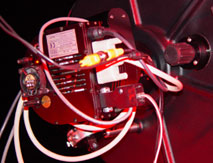
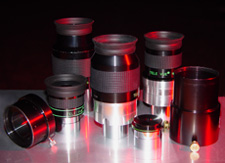
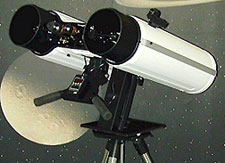
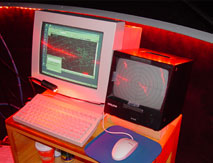 One of our specialities at New Mexico Skies is helping you learn the art of CCD imaging.
One of our specialities at New Mexico Skies is helping you learn the art of CCD imaging. 




 All of the observatories at New Mexico Skies have permanent telescopes mounted on concrete/steel
piers that are solidly attached to bedrock and isolated from the observatory floor. The
concrete/steel pier assemblies are truly massive, weighing in at 2-3 tons, and are pinned
and bonded directly to bedrock. The steel piers are tuned with sand to be non-resonant.
120-volt ground fault protected power outlets are provided at every pier.
All of the observatories at New Mexico Skies have permanent telescopes mounted on concrete/steel
piers that are solidly attached to bedrock and isolated from the observatory floor. The
concrete/steel pier assemblies are truly massive, weighing in at 2-3 tons, and are pinned
and bonded directly to bedrock. The steel piers are tuned with sand to be non-resonant.
120-volt ground fault protected power outlets are provided at every pier.

 Dome 3 contains an unparalleled .51 meter (20") at f/6.0 RCOS Ritchey-Chretien truss
tube telescope mounted on a Bisque Paramount ME. The camera is an SBIG ST-10XME, 2184 x
1472 pixels, each 6.8 microns square. The telescope is equipped with a Precision Instrument
Rotator and an SBIG AO-7 Adaptive optics device. The field of view is 11 x 17 arc-minutes.
This telescope is dedicated to advanced CCD imaging and is only available to experienced
imagers.
Dome 3 contains an unparalleled .51 meter (20") at f/6.0 RCOS Ritchey-Chretien truss
tube telescope mounted on a Bisque Paramount ME. The camera is an SBIG ST-10XME, 2184 x
1472 pixels, each 6.8 microns square. The telescope is equipped with a Precision Instrument
Rotator and an SBIG AO-7 Adaptive optics device. The field of view is 11 x 17 arc-minutes.
This telescope is dedicated to advanced CCD imaging and is only available to experienced
imagers.

 Pads 5 and 6 are the homes for our BIG Dobs: a 30" f/5.0 Tectron, a 25" f/4.0 Galaxy
Mirror/ AstroSystems Telekit and a 15" f/4.0 AstroSystems Telekit. Each of our big Dobsonians
is equipped with a Telrad and Sky Commander digital setting circles. The Sky Commanders
make finding faint fuzzies extremely easy, and we'll teach you how to use them as part of
your telescope checkout.
Pads 5 and 6 are the homes for our BIG Dobs: a 30" f/5.0 Tectron, a 25" f/4.0 Galaxy
Mirror/ AstroSystems Telekit and a 15" f/4.0 AstroSystems Telekit. Each of our big Dobsonians
is equipped with a Telrad and Sky Commander digital setting circles. The Sky Commanders
make finding faint fuzzies extremely easy, and we'll teach you how to use them as part of
your telescope checkout.